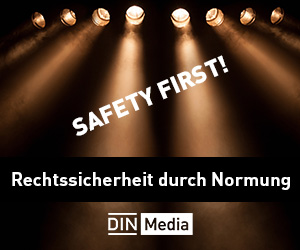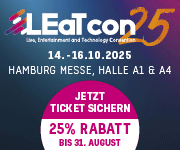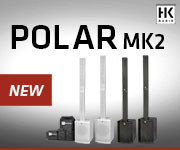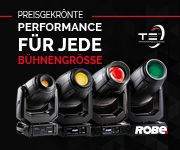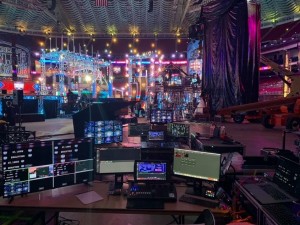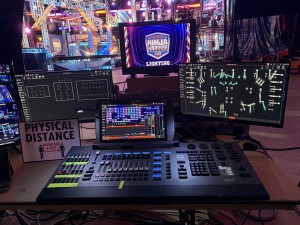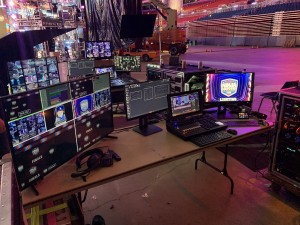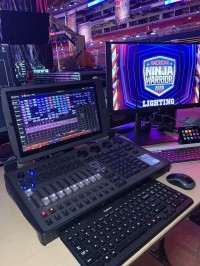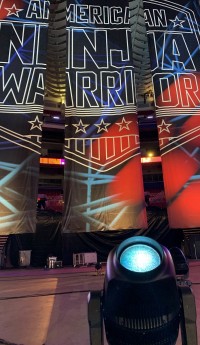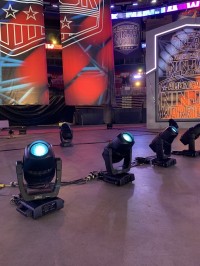Aktuelle News & Schlagzeilen
Corona: Elation lighting and Obsidian control on “American Ninja Warrior”
On March 12, Season 12 filming of NBC’s primetime series “American Ninja Warrior” was postponed in the middle of production in Los Angeles, and just one day before the reality competition was set to get underway beneath an Elation lighting rig with Obsidian control system. Delayed due to the Covid-19 pandemic, the show eventually headed into production again in July.
Lighting was under the hands of Adam Biggs (lighting design) and Ed Motts (lighting direction). “We were all ready to shoot when the producers called us in and announced they were postponing the show as a health measure so we immediately started loading out that night”, recalls Motts, now in his eighth year with the show. “Then we sat at home like everyone else in the industry until we got a call in early June about possibly coming back for one city. By our June 25th tech meeting we knew it was a go.”
Season 12 of “American Ninja Warrior” was filmed at The Dome at America’s Center in St. Louis during the middle of July and will air this fall on NBC. This was the first time a season has been shot in just one location as they usually film from three or four different cities across multiple weeks. Season 12 should have started in Los Angeles before moving to St. Louis and Washington, D.C. with the finale in Las Vegas. Instead, four preliminary rounds, two semifinals and a finale were taped at the multi-purpose Dome in St. Louis.
The eight days of broadcasts featured a nearly all Elation lighting rig, which ran on a complete Obsidian Control Systems network. An Obsidian NX4 console served as the main controller with a compact NX2 used as a tracking backup with Netron EN12 and EN4 Ethernet to DMX gateways used for data distribution. In addition, an interview area was under Onyx control using a laptop and a two-port dongle.
Aspect Lighting has supplied an Elation lighting system for “American Ninja Warrior” for years and the 2020 season was no exception. The southern California-based event lighting company provided SixPar 100 IP and SixPar 300 IP LED Par lights, SixBar 1000 IP LED battens, Cuepix 16 IP LED matrix panels, Proteus Hybrid moving heads, Paladin LED effect lights and Platinum Beam 5R Extreme movers, along with a smattering of other lighting.
Motts says the course was switched out every night, which precipitated the use of three crews. “We worked around the clock, a morning crew to remount lights back in the course for areas that had been moved, a show crew to run it, and then a night crew to pull out the lights on whatever courses were being swapped out.”
The lighting control system runs on a total of sixty Universes covering ten obstacles per course across multiple courses. “We break it up so that if we need to take a course or obstacle to a different look, a different color for example, in order to do a promo or something then the programmers can easily switch it. That’s how we identify it. We have sixty Universes but not every Universe is full.” Motts says he ran Cat5 cable out to the Netron devices that distributed the signal from multiple points along the course: start line, mid-way, between certain obstacles, and at the course’s end.
The Cuepix panels played a special role along three segments of the course. Using the NX4’s built-in Dylos pixel composer, Motts ran a number of looks across the 4x4 matrix LED panels. “We ran Dylos effects through the course at the start line, the warp wall, and the final climb which also had an LED screen”, he says, noting that he used content from Dylos itself. “We sized it, colored it and made it our own essentially.”
“American Ninja Warrior” was one of the first major television shows using the NX4 with Dylos. Motts says that in a normal year with multiple tapings going on at the same time, they usually have two different control systems out on the road; one the NX4/NX2 system and the other two M6 controllers that he says will be upgraded to the new Onyx platform so they can run Dylos.
Motts says the taping was all about making a safe show and that the production company, A. Smith & Co. Productions, kept the crew’s health as a top priority. “There was a team of people who were making sure that we were safe and that everything that was being done was done correctly. We were tested often with temperature checks every morning and daily surveys to ask about our health. Everyone wore masks and social distanced and there was hand sanitizer everywhere”, he says, though he admits he was a little nervous with all the cleaning and spraying of disinfectant on the consoles. “There were quite a few people around so the consoles were getting sprayed every 10-15 minutes all day long, plus at night they did an electrostatic cleaning. At one point, I was a bit worried that the buttons were going to fade but they held up great.”
SCHLAGZEILEN
news archiv
suche
© 1999 - 2025 Entertainment Technology Press Limited News Stories

